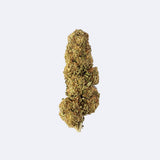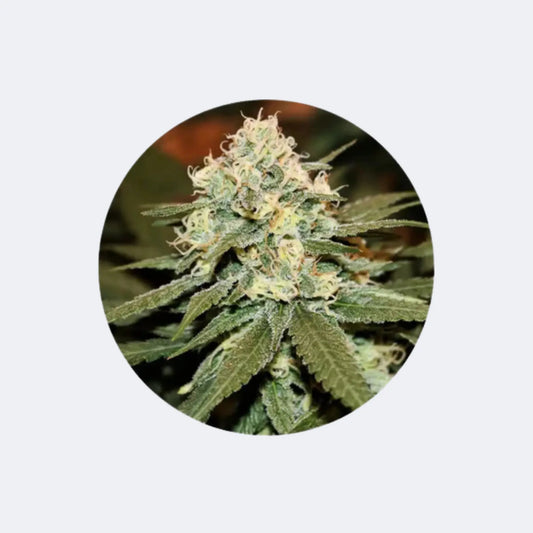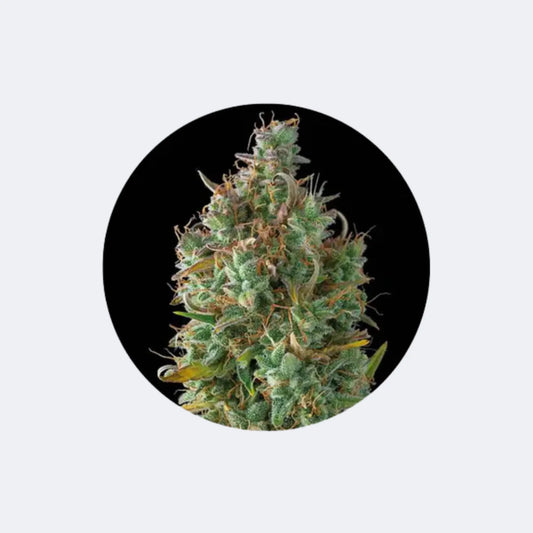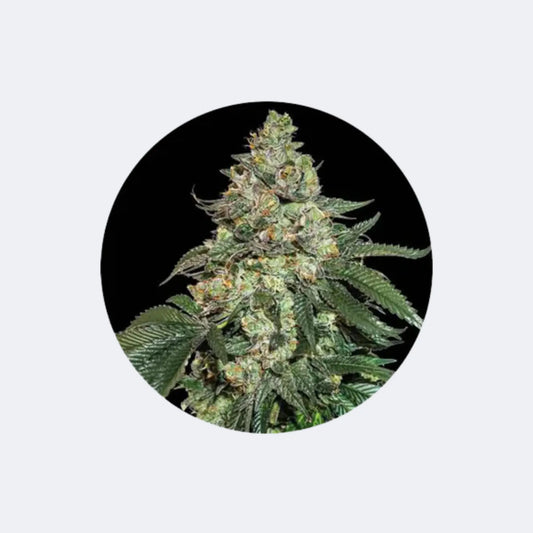
TOPPING - High-Stress Training Method for Cannabis
Andreas LeschkeShare blog post
How to trigger a true Medusa effect as a marijuana executioner
In today's blog post, we will look at a very effective method of increasing yields, after having covered the basics of growing miracle plants at home in previous blog posts.
The so-called "topping" already reveals, through the training term "high stress," that enormous effort is required from the weed plant, where it must summon all its courage and energy to survive this intense method and explode. Therefore, it is of paramount importance that your beloved fun plant does not exhibit any stress symptoms at the time of topping!
Anyone who has a healthy plant with guaranteed nutrient supply does not have to fear topping, as it is certain that after this severe intervention, the plant will experience a pushback that will transform the once slender lady into a true cannabis bush.
There are many myths and rumors circulating online about topping. I keep reading that you shouldn't top automatics, but there are no concerns about this with photoperiod genetics.
This theory is incorrect because topping is usually done before the onset of the flowering phase. By this point, the plant has formed sufficient nodes for this training measure, and it still has 4-5 weeks from the beginning of the flowering period for the side shoots to grow and develop.
This is also the case with "Automatics", but to a different extent!
Because even if internet rumors claim otherwise, I have also found that topping works wonderfully with automatics if it takes place at the beginning of the flowering phase, when the first flower hairs are visible.
The only difference between automatic seeds and feminized, photoperiod seeds is the shorter veggie phase of automatics. However, topping your automatic plant at the end of the veggie phase to turn it into a bush is possible and will also lead to increased yields, just as with photoperiod genetics.
With photoperiod genetics, you have the advantage of being able to top the plant multiple times, as the veggie phase lasts 4 to 5 months longer if you don't flower it earlier.
For this reason, we will now first focus on the basics of topping, which will make it easier to understand why it leads to this transformation from a slender cannabis plant to a bushy, full-blooded lady.

Meaning and implementation of "TOPPING" and what it triggers in the plant
During the "topping" process, as banal as it may sound, the plant is beheaded and surely everyone can now imagine what an extreme strain this process represents for our beloved medicinal plant.
For this reason, as already mentioned, it's important that the plant is healthy and stress-free, but also that you work in a clean and sterile environment. Therefore, please wear clean gloves and use clean and disinfected scissors during this process to ensure that no germs, viruses, or bacteria can penetrate the plant's wound.
Typically, the first topping is recommended once the plant has formed 4 to 6 nodes or pairs of leaves. This usually occurs after 2 to 4 weeks, depending on the genetics.
Other sources recommend topping the plant only when it has already developed 7 nodes in order to eliminate the top two nodes.
So don't let this discourage or even confuse you, because topping is mainly about stopping the vertical growth of the main stem so that the plant can redirect its power into the side shoots.
In this way, they grow more vigorously and form more side shoots, which increases the number of buds explosively.
The goal of topping is not only to achieve a headbud like an untopped weed lady, but to get many more large head flowers!!!
Topping not only presents your plant with extreme challenges, it will also boost the plant's will to survive in such a way that it will generate far more energy and drive than it would without this stress method.
It is an easy-to-implement boost to effectively increase yield.
It is important to note that from the time of topping, the plant requires an increased amount of nutrients, which makes regular re-fertilization of the soil essential.
It doesn't matter whether you start topping your photoperiod lady when she only has 4 nodes to remove the top node, or whether you top your miracle plant only when she has 7 nodes. Both methods work, but ultimately produce different results and require different goals and measures from the grower.
If you top your plant when it is very young and leave only 2 or 3 nodes, the shoots will grow and develop extremely quickly, so that you can top them further.
Some professionals top the new shoots after the first node to encourage the plant to spread even further. This can lead to homegrown yields of up to 400g of dried flowers. However, you'll need to allow for a growth period of 3 to 4 months to achieve this result.
If you top your plant later and remove two nodes, you can take cuttings from the remaining cut. We'll cover this topic in another blog post at a later date. Nevertheless, I wanted to mention it briefly.
It's important to consider the size of the grow box and how much space the plant has to expand. A plant topped two or three times requires far more space in width than a weed lady that hasn't been topped or has only been topped once.
Also, not all genetics are capable of multiple topping, so we will now focus on the different genetics of auto vs. feminized seeds.
Topping with Automatic Genetics
Genetics that initiate the flowering phase automatically often have different growth phases. Therefore, you should first check the profile of your chosen genetic to see how long the vegetative phase lasts, because topping with automatic seeds only works if you have a vegetative phase of 3-4 weeks before the flowering period.
Therefore, pay attention to when the first flower hairs appear, as this is the latest time for topping. While you'll lose a few days for the plant to recover from the shock, the growth phase during the flowering period lasts another 4-5 weeks, allowing sufficient time for stable and strong side branches to develop, allowing for more large headbuds to be harvested.
As a rule, automatics should only be topped when they have developed at least four nodes. When doing so, cut off the top node, which can be safely discarded.
An earlier topping, for example to preserve only 2 nodes, would make no sense, as there would be no growth time to top the lateral shoots again to allow a vigorous spread of new side shoots.
It would make no sense to cultivate a cutting of the Automatic, as it, like the cutting's mother plant, will begin to flower just a few days after topping without having enough time to grow.
Anyone who tops an automatic in a timely manner can double their yield using this method. However, it should be noted that automatics should only be topped once, as further topping during the flowering period (except at the very beginning) is absolutely taboo and will lead to failure. Additionally, the shoots should be manipulated in their growth direction with plant clips to ensure they all receive sufficient light. However, since this low-stress training method using plant clips is a separate topic, we will cover it in the next blog post.
Topping with feminized, photoperiod genetics
Photoperiod cannabis ladies have the major advantage over their autoflowering counterparts in that they enjoy a much longer growth phase. This allows us to give the plant more time to develop, allowing for multiple toppings.
The question of whether it is better to top the Weed Lady early or later is therefore entirely at the discretion of the hobby gardener and the space the plant has available to spread.
Early topping is usually started when the plant has developed 3-4 nodes, so that the top one or two nodes are removed.
In this way, you achieve a very short main stem, which means that the plant remains low for the time being until the side shoots grow upwards.
If you top the side shoots again after the first or second new node, the power and nutrient supply is directed to the new side shoots, which gives them a further boost and causes new side shoots to develop.
It is important to note that after each topping, you give your plant enough time, from one to two weeks, to recover and develop new side shoots!
By constantly developing new side shoots, the plant grows in width and less in height, as if it were not topped at all or only once.
Experience shows that up to two toppings result in several large headbuds. If the plant receives more than two toppings, we home growers consider it "uneconomical," as each topping extends the growth phase and thus delays the harvest. Furthermore, the head buds become increasingly smaller after the second topping, with each topping.
This can be an advantage, as smaller flowers dry more quickly and the risk of mold is lower with small flowers than with flowers that are too large.
It's therefore up to your personal decision how often you top the plant. I personally prefer simple topping because it's more manageable for me, and it's easier to use low-stress clips to shape the shoots in a direction that ensures they receive sufficient light penetration.
If you top your plant after the fourth node, as I like to do, you'll harvest eight large head buds instead of one large head flower. If you allow your plant to continue growing for 3-4 weeks after topping before inducing flowering, new side shoots will develop, increasing the yield with additional smaller flowers.
This ultimately results in a medium-sized bush with a multitude of flowers, with at least twice the yield than without the topping.
But here too, it is important to use low-stress brackets to guide the shoots in their growth direction so that they all receive sufficient light to develop and grow large and strong.
Finally, I must emphasize again that every topping means extreme stress for the plant, so it is all the more important to give it sufficient time and nutrients for recovery and push-back afterwards.
Therefore, I belong to the category of home growers who only top the plant once, because I don't have to accept any further growth loss from further topping and in 3-4 weeks I can ensure that the plant is strong and healthy, so that it enjoys sufficient shoots and side branches, where it produces happy and juicy buds as soon as I initiate flowering.
The economic viability here is clear:
Instead of four weeks of veggie growth, I have to invest four more weeks. This means my grow takes about a month longer than without topping. In return, I get more than double the yield. The extra month doubles the yield.
Considering that on average a weed lady without topping needs 3 months to be ready for harvest, the patience to invest an extra month will be rewarded with at least double the yield.
We thank the author Jorge Rieger for this blog post on "TOPPING - High-Stress Training Method for Cannabis." Feel free to follow him on his Facebook account. --> Click here






